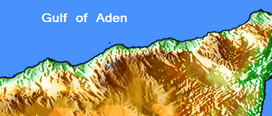Ogo Mountains
This article needs additional citations for verification. (December 2018) |
| Ogo Mountains Galgodon Highlands[1] Buuraha Oogo جَبَل أوغو | |
|---|---|
 Cal Madow, a subrange of the Ogo Mountains | |
| Highest point | |
| Peak | Shimbiris |
| Elevation | 2,450 m (8,040 ft) |
| Coordinates | 10°44′03.3″N 47°13′56.6″E / 10.734250°N 47.232389°E |
| Geography | |
| Country | |
| Regions | Sanaag and Togdheer |
The Ogo Mountains (Ogo Highlands), also known as the Galgodon Highlands,[1] (Somali: Buuraha Oogo, Arabic: جبل أوغو) are a mountain range in the country of Somaliland. They cross the Sanaag and Togdheer regions. With a mean peak height of 2,450 m (8,040 ft), the ecology of this landform is semi-desert.
According to the CULTURAL ORIENTATION SOMALI published by the Defense Language Institute in 2020, the Golis Mountains is another name for the Galgala Hills, part of the Karkaar mountain range, and the Ogo Highlands are south of the Karkaar mountain range.[2] However, the areas to which these place names refer vary from literature to literature.
Ecology
[edit]
Due to the Ogo Mountains' elevated, highland location in Somaliland, the range has an unexpectedly temperate climate.[3] The mountains also catch the precipitation of the Indian Ocean's monsoon winds, resulting in a rainy season that lasts from June until mid-September.[citation needed]
Climate
[edit]The average annual temperature in the Ogo Mountains is 20 to 26 °C (68 to 79 °F). Precipitation reaches a maximum in March, with a minimum of rainfall in August. The average annual precipitation around 500–700 mm (20–28 in).[3]
The data provided below derives from the Gudaado station. It illustrates a subtropical highland climate with strong continental Mediterranean characteristics (Köppen: "Cwb"), given the two marked wet seasons that span between March–May and September–November, albeit the latter being briefer and more subtle. The climatic situation here is most similar to the Altiplano region, due to its semi-arid patterns of rain, huge diurnal temperature variations, adjacence to the Somali desert, and seasonal variations that are neither too cold nor too hot in the extremes.
| Climate data for Gudaado (10°44'03.3"N 47°13'56.6"E) (elev. 2239 metres above sea level) | |||||||||||||
|---|---|---|---|---|---|---|---|---|---|---|---|---|---|
| Month | Jan | Feb | Mar | Apr | May | Jun | Jul | Aug | Sep | Oct | Nov | Dec | Year |
| Mean daily maximum °C (°F) | 22.6 (72.7) |
23.7 (74.7) |
24.1 (75.4) |
23.8 (74.8) |
24.6 (76.3) |
27.1 (80.8) |
27.1 (80.8) |
26.9 (80.4) |
26.4 (79.5) |
23.0 (73.4) |
22.3 (72.1) |
22.2 (72.0) |
24.5 (76.1) |
| Daily mean °C (°F) | 16.7 (62.1) |
17.8 (64.0) |
19.0 (66.2) |
19.6 (67.3) |
20.0 (68.0) |
22.0 (71.6) |
22.3 (72.1) |
22.1 (71.8) |
21.3 (70.3) |
18.1 (64.6) |
17.0 (62.6) |
16.4 (61.5) |
19.4 (66.8) |
| Mean daily minimum °C (°F) | 11.7 (53.1) |
12.8 (55.0) |
14.3 (57.7) |
15.6 (60.1) |
16.1 (61.0) |
17.3 (63.1) |
17.8 (64.0) |
17.8 (64.0) |
17.1 (62.8) |
13.9 (57.0) |
12.5 (54.5) |
11.6 (52.9) |
14.9 (58.8) |
| Average rainfall mm (inches) | 9 (0.4) |
17 (0.7) |
58 (2.3) |
160 (6.3) |
140 (5.5) |
6 (0.2) |
1 (0.0) |
3 (0.1) |
22 (0.9) |
90 (3.5) |
35 (1.4) |
12 (0.5) |
553 (21.8) |
| Source: Climate Data[3] | |||||||||||||
See also
[edit]- Lamadaya waterfalls
References
[edit]- ^ a b "Galgodon Highlands". Encyclopædia Britannica. Retrieved 25 June 2013.
- ^ DEFENSE LANGUAGE INSTITUTE FOREIGN LANGUAGE CENTER TECHNOLOGY INTEGRATION (2020). "CULTURAL ORIENTATION SOMALI" (PDF). Retrieved 2 May 2023.
- ^ a b c "Climate Guadaado, Somalia". Climate Data. Retrieved 9 April 2012.


